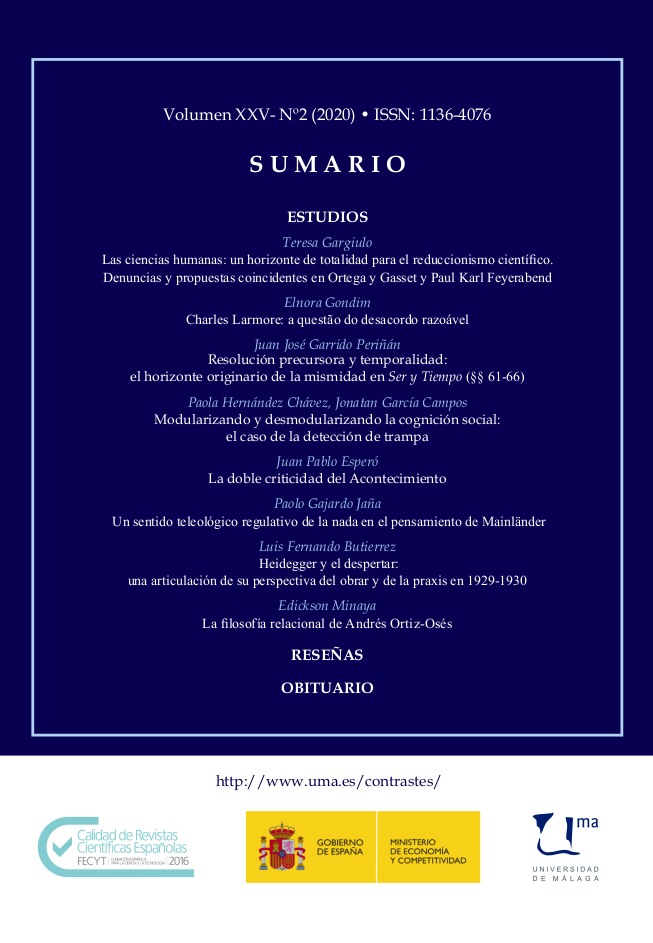Modularizing and De-modularizing Social Cognition: The Cheating Detection Module Case
DOI:
https://doi.org/10.24310/Contrastescontrastes.v25i2.7483Keywords:
SOCIAL COGNITION, MODULARITY, MASSIVE MODULARITY, BRAIN SPECIALIZATION, CHEATING DETECTIONAbstract
This work reviews the classic literature on cognitive modularity. A neuronal cognitive account of modularity is offered, which includes: specific breakdown patterns, double dissociation, an associated brain activity, and a process of functional specialization. Thereupon, a social cognition module is analyzed, i.e., the cheating detection module. The classic objections to this module are compiled, while some original ones are displayed, and then contrasted with the former account. The last part advances some implications and future directions for current social cognition studies.Downloads
Metrics
Publication Facts
Reviewer profiles N/A
Author statements
Indexed in
-
—
- Academic society
- N/A
- Publisher
- Universidad de Málaga
References
Adams, M (2011). Modularity, theory of mind, and autism spectrum disorder. Philosophy of Science, 78, 763-773. doi:10.1086/662269.
Baron-Cohen, S., Frith, U., & Leslie, A (1985). Does the autistic child have a ‘theory of mind’?. Cognition, 21, 37-46. doi:10.1016/0010-0277(85)90022-8.
Buller, D (2005). Adapting minds: evolutionary psychology and the persistent quest for human nature. Cambridge, MA: MIT Press. https://mitpress.mit.edu/books/adapting-minds
Carruthers, P (2006). The architecture of the mind: Massive modularity and the flexibility of thought. Oxford, England: Clarendon Press. https://books.google.com.mx/books/about/The_Architecture_of_the_Mind.html?id=RUAVDAAAQBAJ&printsec=frontcover&source=kp_read_button&redir_esc=y#v=onepage&q&f=false
Cosmides, L., & Tooby, L. (1992). Cognitive adaptations for social exchange. En J. Barkow, L. Cosmides & J. Tooby (Eds.), The adapted mind: evolutionary psychology and the generation of culture (pp. 163-228). New York, NY: Oxford University Press. https://psycnet.apa.org/record/1992-98504-003.
Cosmides, L., Tooby, J., Fiddick, L., & Bryant, G (2005). Detecting cheaters. Trends in cognitive science, 9, 505-506. DOI: https://doi.org/10.1016/j.tics.2005.09.005
Cummins, D. (2000). How the social environment shaped the evolution of mind. Synthese, 122, 3-28. https://doi.org/10.1023/A:1005263825428
Dehaene, S., & Cohen, L (1991). Two mental calculation systems: A case study of severe acalculia with preserved approximation. Neuropsychologia, 29, 1045-1074. doi:10.1016/0028-3932(91)90076-k
Gerrans, P., & Stone, V (2008). Generous or parsimonious cognitive architecture? Cognitive neuroscience and theory of mind. British Journal of Philosophy of Science, 59, 121-141. https://doi.org/10.1093/bjps/axm038
Gigerenzer, G., & Hug, K (1992). Domain-specific reasoning: Social contracts, cheating, and perspective change. Cognition, 43, 127-171. DOI: 10.1016/0010-0277(92)90060-u
Elbert, T., Pantev, C., Wienbruch, C., Rockstroh, B., & Taub, E (1995). Increased cortical representation of the fingers of the left hand in string players, Science, 270, 305-307. DOI: 10.1126/science.270.5234.305
Ermer, E., Guerin, S., Cosmides, L., Tooby, J., & Miller, M (2006). Theory of mind broad and narrow: Reasoning about social exchange engages ToM areas, precautionary reasoning does not. Social Neuroscience, 1, 196-219. DOI: 10.1080/17470910600989771
Evans, J., & Over, D (1996). Rationality and reasoning, East Sussex, England: Psychology Press. https://doi.org/10.1016/0010-0277(93)90039-X
Fodor, J. (1983). The modularity of mind: An essay on faculty psychology, Cambridge, MA: MIT Press. DOI: https://doi.org/10.1017/CBO9780511814273.046
Hernández-Chávez, Paola (2016), Modularidad cognitiva y especialización cerebral (2016), CEFPSVLT-SEP. Mexico. https://www.academia.edu/33396673/Modularidad_Cognitiva_y_Especialización_Cerebral
Karmiloff-Smith, A (2011). Static snapshots versus dynamic approaches to genes, brain, cognition, and behavior in neurodevelopmental disabilities. International review of research in developmental disabilities: early development in neurogenetic disorders, 40, 1-15. https://doi.org/10.1016/B978-0-12-374478-4.00001-0
Machery, E (2007). Massive modularity and brain evolution. Philosophy of Science, 74, 825-838. https://doi.org/10.1086/525624
Maguire, E. A., Gadian, D. G., Johnsrude, I. S., Good, C. D., Ashburner, J., Frackowiak, R. S., & Frith, C. D. (2000). Navigation-related structural change in the hippocampi of taxi drivers. Proceedings of the National Academy of Sciences, 97(8), 4398-4403. https://doi.org/10.1073/pnas.070039597
Mill, J. S (1882). A system of Logic, New York, NY: Harper & Brother Publishers. https://www.gutenberg.org/files/26495/26495-pdf.pdf
Mithen, S (1996). The prehistory of mind: a search for the origins of art, religion, and science, London, England: Thames and Hudson. https://www.journals.uchicago.edu/doi/abs/10.1086/jar.52.4.3630315
Parsons, L., & Osherson, D (2001). New evidence for distinct right and left brain systems for deductive versus probabilistic reasoning. Cerebral Cortex, 11, 954-965. https://doi.org/10.1093/cercor/11.10.954
Patterson, L., & Kay, J (1982). Letter-by-letter reading: Psychological descriptions of a neurological syndrome, Quarterly Journal of Experimental Psychology, 34, 411-441. https://doi.org/10.1080/14640748208400852
Polk, T., & Hamilton, J (2006). Reading, writing, and arithmetic in the brain: Neural specialization for acquired functions, En P. Baltes, P. Reuter-Lorenz & F. Rosler (Eds.), Lifespan Development and Brain: The perspective of biocultural co-constructivism (pp. 183-199). New York, NY: Cambridge University Press. DOI: 10.1017/CBO9780511499722.010
Pinker, S (1994) The language instinct: how the mind creates language. New York, NY: HarperCollins Publishers. https://stevenpinker.com/publications/language-instinct
Ptito, M., & Desgent, S. (2006). Sensory input-based adaptation and brain architecture. En P. Baltes, P. Reuter-Lorenz & F. Rosler (Eds.), Lifespan Development and Brain: The perspective of biocultural co-constructivism (pp. 111-133). New York, NY: Cambridge University Press. DOI: 10.1017/CBO9780511499722.007
Sperber, D. (1994). The modularity of thought and the epidemiology of representations. En L. Hirschfeld & S. Gelman (Eds.), Mapping the mind: Domain specificity in cognition and culture (pp. 39-67). Ney York, NY: Cambridge University Press. DOI: https://doi.org/10.1017/CBO9780511752902.003
Sperber, D. (2002). In defense of massive modularity. En I. Dupoux (Ed.), Language, Brain, and Cognitive Development (pp. 47-57). Cambridge, MA: MIT Press. http://www.dan.sperber.fr/wp-content/uploads/2001_in-defense-of-massive-modularity.pdf
Downloads
Published
How to Cite
Issue
Section
License
This journal provides immediate free access to its content under the principle of making research freely available to the public. All content published in Contrastes. Revista Internacional de Filosofía, are subject to the Creative Commons Attribution-NonCommercial-ShareAlike 4.0 license whose full text can be found at <http://creativecommons.org/licenses/by-nc-sa/4.0>
It is the responsibility of the authors to obtain the necessary permissions of the images that are subject to copyright.
Authors whose contributions are accepted for publication in this journal will retain the non-exclusive right to use their contributions for academic, research and educational purposes, including self-archiving or repository in open access repositories of any kind.
The electronic edition of this magazine is edited by the Editorial Service of the University of Malaga (Uma Editorial), being necessary to cite the origin in any partial or total reproduction.










5.png)
